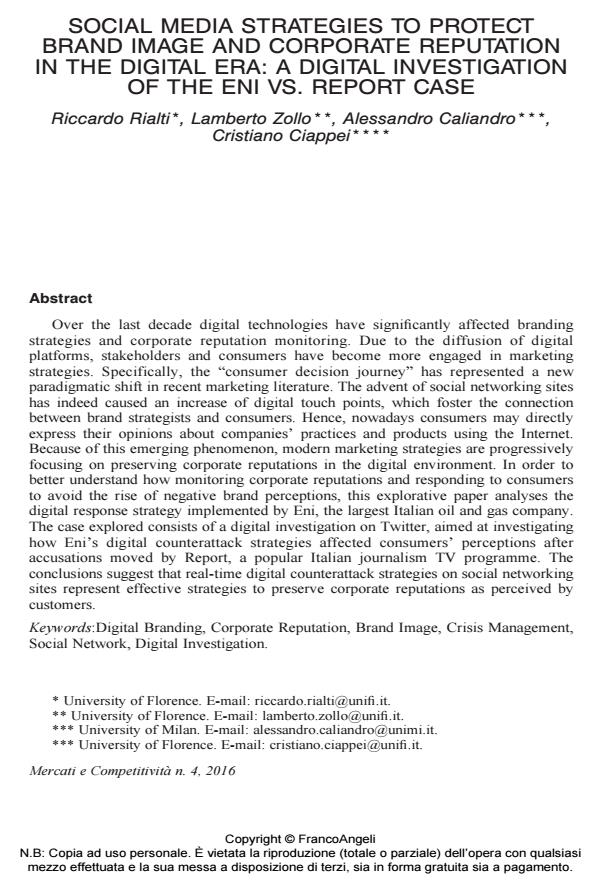Social media strategies to protect brand image and corporate reputation in the digital era: a digital investigation of the Eni vs. Report case
Titolo Rivista MERCATI & COMPETITIVITÀ
Autori/Curatori Riccardo Rialti, Lamberto Zollo, Alessandro Caliandro, Cristiano Ciappei
Anno di pubblicazione 2016 Fascicolo 2016/4
Lingua Inglese Numero pagine 20 P. 65-84 Dimensione file 185 KB
DOI 10.3280/MC2016-004005
Il DOI è il codice a barre della proprietà intellettuale: per saperne di più
clicca qui
Qui sotto puoi vedere in anteprima la prima pagina di questo articolo.
Se questo articolo ti interessa, lo puoi acquistare (e scaricare in formato pdf) seguendo le facili indicazioni per acquistare il download credit. Acquista Download Credits per scaricare questo Articolo in formato PDF

FrancoAngeli è membro della Publishers International Linking Association, Inc (PILA)associazione indipendente e non profit per facilitare (attraverso i servizi tecnologici implementati da CrossRef.org) l’accesso degli studiosi ai contenuti digitali nelle pubblicazioni professionali e scientifiche
Over the last decade digital technologies have significantly affected branding strategies and corporate reputation monitoring. Due to the diffusion of digital platforms, stakeholders and consumers have become more engaged in marketing strategies. Specifically, the "consumer decision journey" has represented a new paradigmatic shift in recent marketing literature. The advent of social networking sites has indeed caused an increase of digital touch points, which foster the connection between brand strategists and consumers. Hence, nowadays consumers may directly express their opinions about companies’ practices and products using the Internet. Because of this emerging phenomenon, modern marketing strategies are progressively focusing on preserving corporate reputations in the digital environment. In order to better understand how monitoring corporate reputations and responding to consumers to avoid the rise of negative brand perceptions, this explorative paper analyses the digital response strategy implemented by Eni, the largest Italian oil and gas company. The case explored consists of a digital investigation on Twitter, aimed at investigating how Eni’s digital counterattack strategies affected consumers’ perceptions after accusations moved by Report, a popular Italian journalism TV programme. The conclusions suggest that real-time digital counterattack strategies on social networking sites represent effective strategies to preserve corporate reputations as perceived by customers.
Parole chiave:Digital Branding, Corporate Reputation, Brand Image, Crisis Management, Social Network, Digital Investigation
- Marketing in Culturally Distant Countries Giovanna Magnani, pp.63 (ISBN:978-3-031-04831-9)
- Credibilty, Quality, and Aesthetics on Social Media: The Impact of Influencer Posts on Brand Reputation and Purchase Intention Ebubekir Işık, in İnsan ve Toplum Bilimleri Araştırmaları Dergisi /2025 pp.1211
DOI: 10.15869/itobiad.1606259 - The impact of LinkedIn posts on employer brand perception and the mediating effects of employer attractiveness and corporate reputation Jayesh Joglekar, Caroline S.L. Tan, in Journal of Advances in Management Research /2022 pp.624
DOI: 10.1108/JAMR-10-2021-0343 - Niche tourism destinations’ online reputation management and competitiveness in big data era: evidence from three Italian cases Valentina Cillo, Riccardo Rialti, Manlio Del Giudice, Antonio Usai, in Current Issues in Tourism /2021 pp.177
DOI: 10.1080/13683500.2019.1608918 - Network Models Tiffanie Turner-Henderson, in International Journal of Artificial Intelligence /2024 pp.1
DOI: 10.4018/IJAIBM.365343 - Co-creation experiences in social media brand communities Riccardo Rialti, Alessandro Caliandro, Lamberto Zollo, Cristiano Ciappei, in Spanish Journal of Marketing - ESIC /2018 pp.122
DOI: 10.1108/SJME-03-2018-0011 - A longitudinal investigation into multilevel agile & ambidextrous strategic dualities in an information technology high performing EMNE Vijay Pereira, Manlio Del Giudice, Ashish Malik, Shlomo Tarba, Yama Temouri, Pawan Budhwar, Swetketu Patnaik, in Technological Forecasting and Social Change 120848/2021 pp.120848
DOI: 10.1016/j.techfore.2021.120848 - Sustainable Business Management and Digital Transformation: Challenges and Opportunities in the Post-COVID Era Tamara Vlastelica, Dejana Nikolić, Jelena Krstić, pp.671 (ISBN:978-3-031-18644-8)
- Ambidextrous organization and agility in big data era Riccardo Rialti, Giacomo Marzi, Mario Silic, Cristiano Ciappei, in Business Process Management Journal /2018 pp.1091
DOI: 10.1108/BPMJ-07-2017-0210 - Business Models and ICT Technologies for the Fashion Supply Chain Gemma Nesi, Riccardo Rialti, Lamberto Zollo, Cristiano Ciappei, pp.53 (ISBN:978-3-319-98037-9)
- CEOs of dual marketers organizations: Communication and reputation management issues Francesca Conte, Agostino Vollero, in MERCATI & COMPETITIVITÀ 3/2018 pp.21
DOI: 10.3280/MC2018-003003 - Sustainable consumption in organic food buying behavior: the case of quinoa Costanza Nosi, Lamberto Zollo, Riccardo Rialti, Cristiano Ciappei, in British Food Journal /2020 pp.976
DOI: 10.1108/BFJ-09-2019-0745 - Digital Transformation of SME Marketing Strategies Riccardo Rialti, Lamberto Zollo, pp.81 (ISBN:978-3-031-33645-4)
Riccardo Rialti, Lamberto Zollo, Alessandro Caliandro, Cristiano Ciappei, Social media strategies to protect brand image and corporate reputation in the digital era: a digital investigation of the Eni vs. Report case in "MERCATI & COMPETITIVITÀ" 4/2016, pp 65-84, DOI: 10.3280/MC2016-004005